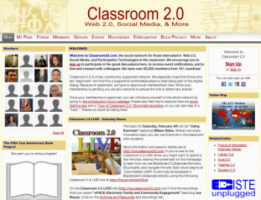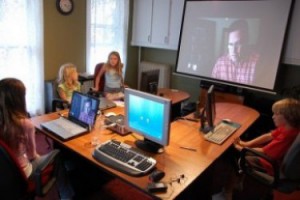Newsroom
Helping Educators Navigate Web 2.0 in a Connected World
A Few Moments with Steve Hargadon

Steve Hargadon’s career in education technology stems from a passionate interest in the role of technology in changing education. Known for being at the forefront of open education resources, web 2.0, and virtual live events, Hargadon has become the go-to expert in educational social networking. In 2007, he created Classroom 2.0, a social networking community for educators using web 2.0 and collaborative technologies, which in the past five years has grown to a network of more than 63,000 members worldwide. He also hosts the Future of Education interview series, a weekly podcast for which he has interviewed a rich and diverse group of key researchers, practitioners, and thought leaders from the ed tech and digital media & learning fields. His newest venture, Teacher 2.0, is designed to help promote the personal and professional growth of educators in a web 2.0 world. As discussions in educational technology begin to shift away from the technology and become more centered around pedagogy, we asked Hargadon what it really means to reimagine learning for a digital age.
When you created Classroom 2.0, your hope was that “those who are ‘beginners’ find it a supportive place to start being part of the digital dialogue.” Tell us about that mission.
Five years ago, the primary tool for educators to start talking to each other was blogging, but blogging was actually a very caustic environment. In order to get your blog comments noticed, you had to say something controversial. Blogging had a lot of all-caps arguments. When Ning shifted their services to a create-your-own-social-network format, I had a lightbulb moment. These educators who want to talk to each other — for whom blogging had been the primary method — should be able to do so in this new environment where instead of feeling that they had to write a five paragraph essay, they could write a one-sentence question or comment. I saw right away this incredible potential for what we were trying to accomplish with education blogging but within the framework of social networking.
What happened in Classroom 2.0 was very gentle because the space was much more egalitarian. In addition to allowing people to come into the community, we worked really hard to create an environment that was respectful. To know beginners need that respect is something I take pride in.
A principal from a Catholic school in the Bay Area once emailed me in Classroom 2.0 and said, “It took me hours to write a single paragraph in the network.” I totally understood where she was coming from. If you spent your life evaluating other people in the written output, being willing to put yourself on the line takes some guts. If you’re used to having a position of power where you evaluate others, then the idea of posting that first post is scary. We created an environment that was really beginner-friendly. There are plenty of other places to go for the more seasoned expert conversations, but we had a vision within Classroom 2.0 that it’s truly a place where beginners would feel comfortable.
You’ve talked about learning as a process. What do you tell those who want to create their own network but haven’t yet made that leap?
Uniquely, the web both rewards authenticity and demands it. One of the things we learned from Clay Shirky early on in “Here Comes Everybody,” is when you’re in an environment where failure is free, you have the liberty to explore ideas and allow those ideas that people care about to grow. You don’t have to force them on people.
What social media does is it rewards the grassroots engagement that bubbles up. Encarta and Wikipedia could be described the same way: both are online encyclopedias, but one is a result of traditional power structure, and the other is the result of grassroots engagement. The two are built in completely different ways, and the one that is built from grassroots engagement has much more success. I tell people to remember to be tapped into engagement. Engagement trumps specific content. What that means is if I am interested as an educator in helping people engage in network activity or in social media, in many ways what I should care about more is engagement because once they’re engaged and excited by it then they will find ways to spread its value.
This model of I’m the teacher so I know what’s best is being replaced by I’m the learner, and I know where I want to go. If I’m interested in creating something that uses social media, I have to allow my learners to have the kind of control that the web allows. I tell creators, “create the network, and if it fails, let it go. Keep creating until you find something that your community fully cares about and leverage that.” You’re trying to help people who want to be engaged learners in a world in which the learner is now able to be more of a driver of their own learning.
Where does the phrase ‘beyond ed tech’ come into play within these 21st century shifts in learning?
Just recently, I spent two days at Stanford at a conference that was sponsored by a Finnish education group called the Cicero Learning Network. Finland has consistently scored at the top of the PISA tests, and everyone wonders how Finland’s testing results relate to their practices and activites. Looking at Finland is like peeling back an onion, layer after layer. Finland wasn’t actually shooting for academic achievement. They were doing things because they cared about them, not for the test results. We look at their practices: shorter school hours; no homework in the lower grades; and high teacher salaries, and we want to replicate those. But if you peel back the onion a little bit more, you’ll see that the reason they were able to support those practices is because they had the desire for equity. They were trying to fund every student at every school the same. The potential conclusion there is that Finland’s success was because of equity, but I don’t think it was equity itself, it was the fact that as a society they could agree on equity.
Unfortunately, we don’t tell a story of equity in the United States; our story is that of opportunity, but in Finland, equity was a story they could all gather around. If you look at places where we have successful education efforts in the United States, typically it’s where the community has agreement on an agenda — often it may be completely different from those practices in Finland — but the community is together in a process of educational success.
 So to me, beyond ed tech is giving voice to stakeholders in the education process who didn’t have a voice before. First it was the teachers, and now it’s going to be the learners. What we’re learning is this process of participation of voice and engagement is really important. It’s the recognition that it isn’t about looking at what specific technology will increase test scores, but it’s about giving voice and allowing people to be engaged in building their own solutions. Whether I am a homeschooler, an alternative schooler, in a chartered school, or in a Los Angeles public school, the technology is allowing for deinstitutionalization. It’s taking power away from institutions — especially narrative power — and placing it in the hands of the individuals. Beyond ed tech gives voice to this powerful group of people who are then learning to use it to be engaged as communities. That’s the magic for me. It’s how giving voice to everybody deinstitutionalizes us. Now we have the challenge of figuring out, in an era where institutions don’t have the power they had before, how to craft the narratives. How do we craft narratives together?
So to me, beyond ed tech is giving voice to stakeholders in the education process who didn’t have a voice before. First it was the teachers, and now it’s going to be the learners. What we’re learning is this process of participation of voice and engagement is really important. It’s the recognition that it isn’t about looking at what specific technology will increase test scores, but it’s about giving voice and allowing people to be engaged in building their own solutions. Whether I am a homeschooler, an alternative schooler, in a chartered school, or in a Los Angeles public school, the technology is allowing for deinstitutionalization. It’s taking power away from institutions — especially narrative power — and placing it in the hands of the individuals. Beyond ed tech gives voice to this powerful group of people who are then learning to use it to be engaged as communities. That’s the magic for me. It’s how giving voice to everybody deinstitutionalizes us. Now we have the challenge of figuring out, in an era where institutions don’t have the power they had before, how to craft the narratives. How do we craft narratives together?
It requires participation from diverse perspectives, but we haven’t really seen that collaboration before.
I think part of the challenge of a variety of stakeholders having a voice is creating an environment for civil dialogue. I am a big believer in the appreciative inquiry approach, meaning appreciating before criticizing. An alternate narrative to equity that we often hear in our culture is one of competing interests. Our legal and political systems are based off competing interests. The same is true of our economic system. We come at problems with this built-in predisposition to compete for answers rather than collaborate for them. One way I think we help alleviate that is to use these tools to bridge conversations through appreciation. Instead of saying that the venture capital tech arena is a negative force, we can ask ourselves, what value are they are bringing? Or if you’re an established technology company, what’s the value you bring? How do we focus on that positive and see that it’s part of a larger picture? I think it’s a matter of approach. Instead of looking at the differences, learn the process of appreciating a variety of viewpoints and then build from there.
If there’s a lesson from web 2.0 for education, it’s that if we engage and participate and build, we have a very different experience than if we’re just followers. Asking people of diverse backgrounds to come together and build a vision of value together in education seems like an appropriately parallel experience to what we hope for students. You can’t ask us to create 21st century engaged students without creating that same environment for teachers and for the community. It’s really hard to teach something that you’re not experiencing or living. So we should want to create an environment for teachers where they can become passionate learners, since we can’t expect a system of engagement for learners if we’re not willing to engage in the same collaborative processes when we think about their work in the education system as whole.
What was the first social network you ever joined?
MySpace. What’s really interesting is that the technologies haven’t changed dramatically, but what has changed the most is our perception of them. If you look at the things that really scared us when we were joining MySpace such as the personal profile page and the comments on the wall, all those things that really made us nervous turned out to be brilliantly suited to learning. The biggest change is our perception of what these technologies do, and especially as parents we were scared of the impact. Part of what we are doing now is looking at these technologies and saying, learning is social. Most of the learning that we do in our lives is social, and these technologies are informing us in brilliant ways about how we interact and how we learn.
Banner image credit: SpecialKRB http://www.flickr.com/photos/specialkrb/5503283241/
Third image credit: willrich http://www.flickr.com/photos/wrichard/1531162055/

